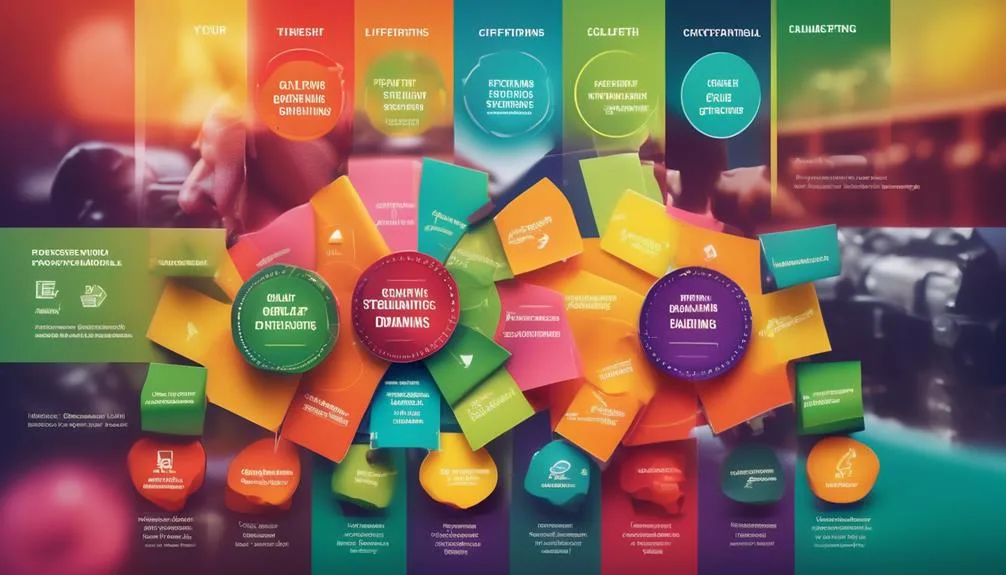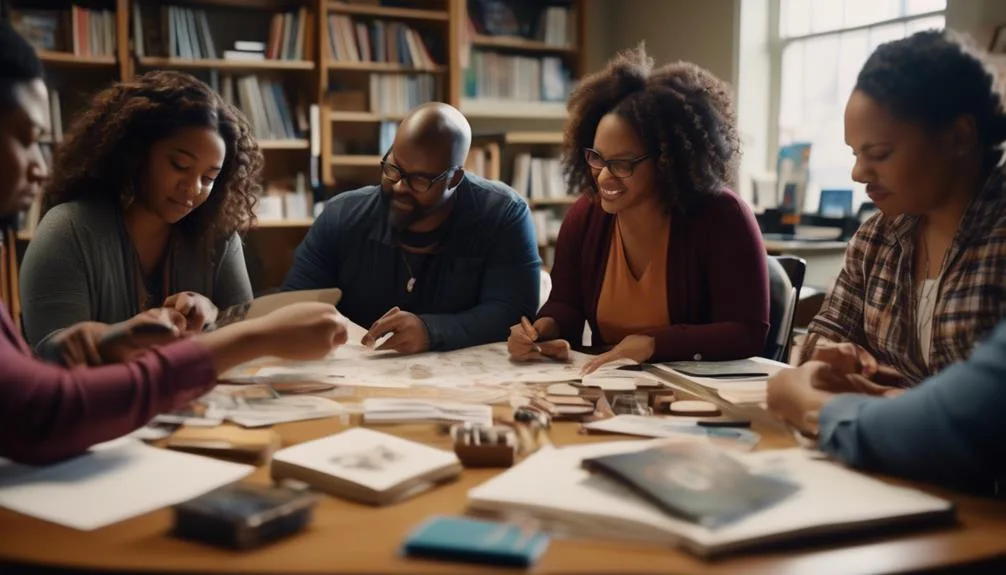Have you ever wondered how to unlock the untapped potential of your team? Is there a way to harness their individual strengths and create a cohesive, high-performing unit?
The CliftonStrengths Assessment offers a promising solution. Developed by Gallup, this assessment aims to identify and understand individual strengths and how they contribute to team success.
But does it really work? Is it worth exploring?
In this discussion, we will delve into the concept of CliftonStrengths and explore its potential to unleash your team's abilities. Get ready to discover a new approach to team building and leadership that could revolutionize your organization.
Key Takeaways
- The CliftonStrengths Assessment helps identify individual strengths and how they contribute to team goals.
- Building teams with complementing strengths leads to successful outcomes.
- High-performing teams possess strengths in the four domains of leadership: Executing, Influencing, Relationship building, and Strategic thinking.
- Effective leadership involves knowing and using strengths, investing in others, and implementing a diverse team.
Understanding CliftonStrengths Assessment
Understanding the CliftonStrengths Assessment is crucial for leaders seeking to optimize team potential and achieve successful outcomes. The benefits of strengths-based leadership are undeniable when it comes to maximizing team performance.
The assessment, developed by Don Clifton and his team, is based on extensive research and data. It helps leaders identify individual strengths and how they contribute to team goals. By investing in and developing these strengths, leaders can build teams with complementing strengths, leading to successful outcomes.
The assessment involves three steps: taking the assessment, receiving personalized reports, and reflecting on the results. It provides leaders with a practical lens for team composition and contribution through the identification of four domains of leadership strengths: Executing, Influencing, Relationship building, and Strategic thinking.
Understanding these strengths enables leaders to identify the right balance of strengths in a team, ultimately enhancing team performance and achieving desired outcomes.
Domains of Strengths According to Gallup

Gallup has identified four domains of leadership strengths that are essential for building high-performing teams and achieving successful outcomes. These domains, namely Executing, Influencing, Relationship building, and Strategic thinking, provide a practical lens for team composition and contribution.
High-performing teams possess strengths in each of these domains, as they bring diverse perspectives and skills that complement one another. Defining leadership strengths within these domains allows leaders to identify the right balance of strengths in a team, ensuring that all necessary aspects of team performance are covered.
The impact of strengths-based team composition is significant, as it fosters collaboration, effective decision-making, and increased productivity. By understanding the strengths within each domain, leaders can create a team that maximizes individual contributions and achieves optimal team performance.
CliftonStrengths Themes and Team Dynamics

To optimize team dynamics and performance, leaders must thoroughly understand the CliftonStrengths themes and their impact on collaboration and productivity. Here are three key insights on how CliftonStrengths themes can maximize strengths and enhance team performance:
- Leveraging individual strengths:
CliftonStrengths provides a comprehensive profile of each team member's unique strengths. By identifying and understanding these strengths, leaders can assign tasks and responsibilities that align with individual capabilities. This allows team members to contribute their best and feel motivated, leading to improved performance.
- Building complementary teams:
CliftonStrengths themes fall under four domains, each representing different aspects of team dynamics. By creating teams with a balanced mix of strengths across these domains, leaders can foster collaboration and synergy. A team with individuals who possess strengths in executing, influencing, relationship building, and strategic thinking will be better equipped to tackle complex challenges.
- Enhancing collaboration and communication:
CliftonStrengths themes also shed light on how team members prefer to work and communicate. Some individuals may excel in executing tasks, while others may thrive in relationship building. Leaders who understand these preferences can encourage effective communication and collaboration, leading to increased productivity and harmony within the team.
Criticisms of Strengths-Based Assessments

Strengths-based assessments have faced criticism for their tendency to overlook weaknesses and oversimplify complex human behavior. Some critics argue that focusing solely on strengths neglects areas for growth and development. They question the validity of these assessments and raise concerns about their impact on individuals' personal and professional development.
Critics argue that by ignoring weaknesses, strengths-based assessments may lead to a lack of self-awareness and hinder individuals from addressing areas where improvement is needed. Additionally, there are concerns that these assessments may contribute to stereotyping and labeling, as they categorize individuals based on their strengths alone.
It's important to consider these criticisms and ensure that strengths-based assessments are used as a tool for growth and development, rather than as a substitute for addressing weaknesses.
Resources and Take-Home Message

For leaders looking to leverage their team's strengths and create a high-performing environment, it's essential to explore the various resources available and understand the key take-home message of the CliftonStrengths™ assessment.
Here are three resources to consider:
- Books on strengths-based leadership: There are numerous books available that delve into the concept of strengths-based leadership, providing practical insights and strategies for leveraging individual and team strengths. These books can help leaders deepen their understanding and application of the CliftonStrengths™ assessment.
- Importance of diverse teams: In order to unleash your team's potential, it's crucial to recognize the importance of diversity. Building teams with a diverse range of strengths and perspectives allows for greater innovation, problem-solving, and adaptability. The CliftonStrengths™ assessment can help leaders identify the right balance of strengths in a team, ensuring that individuals with complementary strengths are brought together.
- PositivePsychology.com: This website offers a wealth of resources and exercises for strengths development. From articles and assessments to worksheets and activities, it's a valuable tool for leaders seeking to maximize their team's potential.
Frequently Asked Questions
How Long Does It Take to Complete the Cliftonstrengths Assessment?
The CliftonStrengths assessment typically takes about 30-45 minutes to complete. It is recommended to retake the assessment every 2-3 years to track changes in strengths.
Can Individuals Retake the Cliftonstrengths Assessment to See if Their Strengths Have Changed Over Time?
Yes, you can retake the CliftonStrengths assessment to see if your strengths have changed over time. This can help you understand any long-term changes in your abilities and how they contribute to team goals.
Are There Any Specific Industries or Professions Where the Cliftonstrengths Assessment Is Most Commonly Used?
In specific industries and professions, the CliftonStrengths assessment is commonly used to enhance team building and collaboration. It helps identify individual strengths and fosters a diverse team that compensates for weaknesses, resulting in successful outcomes.
Can the Cliftonstrengths Assessment Be Used for Personal Development Outside of a Team or Workplace Setting?
Yes, the CliftonStrengths assessment can be used for personal development outside of a team or workplace setting. It promotes personal growth and self-discovery by helping you identify your strengths and how to leverage them effectively.
Are There Any Limitations or Considerations to Keep in Mind When Interpreting the Results of the Cliftonstrengths Assessment?
When interpreting the results of the CliftonStrengths assessment, it's important to consider limitations and factors that may affect the accuracy. Keep in mind that strengths-based approaches may overlook weaknesses and oversimplify human behavior.
Conclusion
In conclusion, by harnessing the power of the CliftonStrengths Assessment, you can unlock your team's potential and create a harmonious, high-performing unit.
Remember, a chain is only as strong as its weakest link, so it's vital to understand and utilize each team member's unique strengths.
As the saying goes, 'teamwork makes the dream work,' and with the CliftonStrengths Assessment, you'll be well-equipped to build a balanced team that drives success and achieves greater outcomes.

